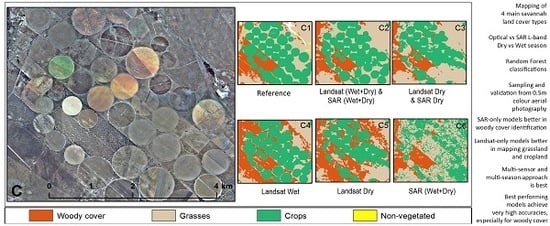Optimisation of Savannah Land Cover Characterisation with Optical and SAR Data
Abstract
1. Introduction
- Do Landsat-based spectral metrics or L-band PALSAR data map the main savannah land cover types more efficiently?
- Does the integration of Landsat and PALSAR data improve mapping?
- Does single or multi-seasonal data produce the most accurate land cover models?
2. Materials and Methods
2.1. Study Area and Description of Main Land Cover Types
- i
- Woody vegetation: trees, shrubs and bushes consisting of areas with either tree cover densities of >15% and the remaining woody cover, consisting of shrubs and bushes, no more than twice that of the tree cover, or of areas dominated by shrubs and bushes with a woody cover of >15% and a tree cover less than twice that of the remaining woody cover. Shrubs and bushes may vary in height up to 3 m. Trees are considered as woody vegetation with a crown elevation of >1.5 m above ground and a total height of >3 m.
- ii
- Grassland: areas dominated by grasses with >4% vegetation cover. Areas may contain up to 15% woody cover. Grasslands may be almost bare during the dry season and during drought episodes.
- iii
- iii Cropland: areas where natural vegetation has been removed or modified and replaced by other types of vegetation cover of anthropogenic origin. This vegetation is artificial and requires human activities to maintain it in the long term. All vegetation that is planted or cultivated with an intent to harvest is included in this class, including cultivated herbaceous graminoids such as maize, sugar cane and cereals. It also includes small fields with subsistence crop farming, all herbaceous non-graminoids such as cotton, sunflower, potatoes, etc., pulses and orchards. The fields may be fallow at certain times during the year.
- iv
- iv Non-vegetated (or bare): this class consists of artificial cover as a result of human activities as well as areas with <4% vegetative cover, including bare rock, sands and unconsolidated bare soil such as animal feed lots, visible erosion, fine rock and soil fragments, as well as areas with bare soil resulting from unfavourable conditions (e.g., low rainfall).
2.2. Data
2.2.1. Aerial photographs
2.2.2. Landsat
2.2.3. PALSAR
2.3. Classification and Validation
3. Results
4. Discussion
4.1. Landsat or PALSAR? or Both?
4.2. Dry or Wet? or Both?
5. Conclusions
Supplementary Materials
Acknowledgments
Author Contributions
Conflicts of Interest
References
- Scholes, R.J.; Walker, B.H. An African Savanna: Synthesis of the Nylsvley Study; Cambridge University Press: Cambridge, UK, 1993. [Google Scholar]
- Wessels, K.; Prince, S.; Malherbe, J.; Small, J.; Frost, P.; Van Zyl, D. Can human-induced land degradation be distinguished from the effects of rainfall variability? A case study in South Africa. J. Arid Environ. 2007, 68, 271–297. [Google Scholar] [CrossRef]
- Wessels, K.J.; van den Bergh, F.; Scholes, R.J. Limits to detectability of land degradation by trend analysis of vegetation index data. Remote Sens. Environ. 2012, 125, 10–22. [Google Scholar] [CrossRef]
- Poulter, B.; Frank, D.; Ciais, P.; Myneni, R.B.; Andela, N.; Bi, J.; Broquet, G.; Canadell, J.G.; Chevallier, F.; Liu, Y.Y. Contribution of semi-arid ecosystems to interannual variability of the global carbon cycle. Nature 2014, 509, 600–603. [Google Scholar] [CrossRef] [PubMed]
- Sankaran, M.; Ratnam, J.; Hanan, N. Woody cover in African savannas: The role of resources, fire and herbivory. Glob. Ecol. Biogeogr. 2008, 17, 236–245. [Google Scholar] [CrossRef]
- Sankaran, M.; Hanan, N.P.; Scholes, R.J.; Ratnam, J.; Augustine, D.J.; Cade, B.S.; Gignoux, J.; Higgins, S.I.; Le Roux, X.; Ludwig, F.; et al. Determinants of woody cover in African savannas. Nature 2005, 438, 846. [Google Scholar] [CrossRef] [PubMed]
- Naidoo, L.; Mathieu, R.; Main, R.; Wessels, K.; Asner, G.P. L-band Synthetic Aperture Radar imagery performs better than optical datasets at retrieving woody fractional cover in deciduous, dry savannahs. Int. J. Appl. Earth Obs. Geoinform. 2016, 52, 54–64. [Google Scholar] [CrossRef]
- Schneibel, A.; Frantz, D.; Röder, A.; Stellmes, M.; Fischer, K.; Hill, J. Using Annual Landsat Time Series for the Detection of Dry Forest Degradation Processes in South-Central Angola. Remote Sens. 2017, 9, 905. [Google Scholar] [CrossRef]
- UNCCD. Global Land Outlook; UNCCD: Paris, France, 2017; p. 338. [Google Scholar]
- Symeonakis, E.; Higginbottom, T. Bush Encroachment Monitoring Using Multi-Temporal Landsat Data and Random Forests. Int. Arch Photogramm. Remote Sens. Spat. Inf. Sci. 2014, 40, 29–35. [Google Scholar] [CrossRef]
- Maestre, F.T.; Eldridge, D.J.; Soliveres, S.; Kéfi, S.; Delgado-Baquerizo, M.; Bowker, M.A.; García-Palacios, P.; Gaitán, J.; Gallardo, A.; Lázaro, R. Structure and functioning of dryland ecosystems in a changing world. Annu. Rev. Ecol. Evolut. Syst. 2016, 47, 215–237. [Google Scholar] [CrossRef] [PubMed]
- Millennium Ecosystem Assessment. Ecosystems and human well-being: Synthesis; World Resources Institute: Washington, DC, USA, 2005. [Google Scholar]
- Kuemmerle, T.; Erb, K.; Meyfroidt, P.; Müller, D.; Verburg, P.H.; Estel, S.; Haberl, H.; Hostert, P.; Jepsen, M.R.; Kastner, T.; et al. Challenges and opportunities in mapping land use intensity globally. Curr. Opin. Environ. Sustain. 2013, 5, 484–493. [Google Scholar] [CrossRef] [PubMed]
- Lehmann, E.A.; Wallace, J.F.; Caccetta, P.A.; Furby, S.L.; Zdunic, K. Forest cover trends from time series Landsat data for the Australian continent. Int. J. Appl. Earth Obs. Geoinform. 2013, 21, 453–462. [Google Scholar] [CrossRef]
- Wulder, M.A.; Masek, J.G.; Cohen, W.B.; Loveland, T.R.; Woodcock, C.E. Opening the archive: How free data has enabled the science and monitoring promise of Landsat. Remote Sens. Environ. 2012, 122, 2–10. [Google Scholar] [CrossRef]
- Bastin, J.-F.; Berrahmouni, N.; Grainger, A.; Maniatis, D.; Mollicone, D.; Moore, R.; Patriarca, C.; Picard, N.; Sparrow, B.; Abraham, E.M.; et al. The extent of forest in dryland biomes. Science 2017, 356, 635–638. [Google Scholar] [CrossRef] [PubMed]
- Kennedy, R.E.; Andréfouët, S.; Cohen, W.B.; Gómez, C.; Griffiths, P.; Hais, M.; Healey, S.P.; Helmer, E.H.; Hostert, P.; Lyons, M.B. Bringing an ecological view of change to Landsat-based remote sensing. Front. Ecol. Environ. 2014, 12, 339–346. [Google Scholar] [CrossRef]
- Senf, C.; Leitão, P.J.; Pflugmacher, D.; van der Linden, S.; Hostert, P. Mapping land cover in complex Mediterranean landscapes using Landsat: Improved classification accuracies from integrating multi-seasonal and synthetic imagery. Remote Sens. Environ. 2015, 156, 527–536. [Google Scholar] [CrossRef]
- Knorn, J.; Rabe, A.; Radeloff, V.C.; Kuemmerle, T.; Kozak, J.; Hostert, P. Land cover mapping of large areas using chain classification of neighboring Landsat satellite images. Remote Sens. Environ. 2009, 113, 957–964. [Google Scholar] [CrossRef]
- Hansen, M.C.; Egorov, A.; Roy, D.P.; Potapov, P.; Ju, J.; Turubanova, S.; Kommareddy, I.; Loveland, T.R. Continuous fields of land cover for the conterminous United States using Landsat data: First results from the Web-Enabled Landsat Data (WELD) project. Remote Sens. Lett. 2011, 2, 279–288. [Google Scholar] [CrossRef]
- Gong, P.; Wang, J.; Yu, L.; Zhao, Y.; Zhao, Y.; Liang, L.; Niu, Z.; Huang, X.; Fu, H.; Liu, S.; et al. Finer resolution observation and monitoring of global land cover: First mapping results with Landsat TM and ETM+ data. Int. J. Remote Sens. 2013, 34, 2607–2654. [Google Scholar] [CrossRef]
- de la Cruz, M.; Quintana-Ascencio, P.F.; Cayuela, L.; Espinosa, C.I.; Escudero, A. Comment on “The extent of forest in dryland biomes”. Science 2017, 358. [Google Scholar] [CrossRef] [PubMed]
- Griffith, D.M.; Lehmann, C.E.R.; Strömberg, C.A.E.; Parr, C.L.; Pennington, R.T.; Sankaran, M.; Ratnam, J.; Still, C.J.; Powell, R.L.; Hanan, N.P.; et al. Comment on “The extent of forest in dryland biomes”. Science 2017, 358. [Google Scholar] [CrossRef] [PubMed]
- Schepaschenko, D.; Fritz, S.; See, L.; Laso Bayas, J.C.; Lesiv, M.; Kraxner, F.; Obersteiner, M. Comment on “The extent of forest in dryland biomes”. Science 2017, 358. [Google Scholar] [CrossRef] [PubMed]
- Olsson, A.D.; van Leeuwen, W.J.D.; Marsh, S.E. Feasibility of Invasive Grass Detection in a Desertscrub Community Using Hyperspectral Field Measurements and Landsat TM Imagery. Remote Sens. 2011, 3, 2283. [Google Scholar] [CrossRef]
- Mathieu, R.; Naidoo, L.; Cho, M.A.; Leblon, B.; Main, R.; Wessels, K.; Asner, G.P.; Buckley, J.; Van Aardt, J.; Erasmus, B.F.N.; et al. Toward structural assessment of semi-arid African savannahs and woodlands: The potential of multitemporal polarimetric RADARSAT-2 fine beam images. Remote Sens. Environ. 2013, 138, 215–231. [Google Scholar] [CrossRef]
- Shimada, M.; Itoh, T.; Motooka, T.; Watanabe, M.; Shiraishi, T.; Thapa, R.; Lucas, R. New global forest/non-forest maps from ALOS PALSAR data (2007–2010). Remote Sens. Environ. 2014, 155, 13–31. [Google Scholar] [CrossRef]
- Higginbottom, T.; Symeonakis, E.; Meyer, H.; van der Linden, S. Mapping Woody Cover in Semi-arid Savannahs using Multi-seasonal Composites from Landsat Data. ISPRS J. Photogramm. Remote Sens. 2017; in press. [Google Scholar]
- Kanniah, K.D.; Beringer, J. Tropical Savanna Ecosystems. Int. Encycl. Geogr. 2017. [Google Scholar] [CrossRef]
- Hüttich, C.; Gessner, U.; Herold, M.; Strohbach, B.J.; Schmidt, M.; Keil, M.; Dech, S. On the suitability of MODIS time series metrics to map vegetation types in dry savanna ecosystems: A case study in the Kalahari of NE Namibia. Remote Sens. 2009, 1, 620–643. [Google Scholar] [CrossRef]
- Hüttich, C.; Herold, M.; Wegmann, M.; Cord, A.; Strohbach, B.; Schmullius, C.; Dech, S. Assessing effects of temporal compositing and varying observation periods for large-area land-cover mapping in semi-arid ecosystems: Implications for global monitoring. Remote Sens. Environ. 2011, 115, 2445–2459. [Google Scholar] [CrossRef]
- Müller, H.; Rufin, P.; Griffiths, P.; Barros Siqueira, A.J.; Hostert, P. Mining dense Landsat time series for separating cropland and pasture in a heterogeneous Brazilian savanna landscape. Remote Sens. Environ. 2015, 156, 490–499. [Google Scholar] [CrossRef]
- Schuster, C.; Schmidt, T.; Conrad, C.; Kleinschmit, B.; Förster, M. Grassland habitat mapping by intra-annual time series analysis—Comparison of RapidEye and TerraSAR-X satellite data. Int. J. Appl. Earth Obs. Geoinform. 2015, 34, 25–34. [Google Scholar] [CrossRef]
- Bleyhl, B.; Baumann, M.; Griffiths, P.; Heidelberg, A.; Manvelyan, K.; Radeloff, V.C.; Zazanashvili, N.; Kuemmerle, T. Assessing landscape connectivity for large mammals in the Caucasus using Landsat 8 seasonal image composites. Remote Sens. Environ. 2017, 193, 193–203. [Google Scholar] [CrossRef]
- Schwieder, M.; Leitão, P.J.; da Cunha Bustamante, M.M.; Ferreira, L.G.; Rabe, A.; Hostert, P. Mapping Brazilian savanna vegetation gradients with Landsat time series. Int. J. Appl. Earth Obs. Geoinform. 2016, 52, 361–370. [Google Scholar] [CrossRef]
- Thomas, D.S.G.; Twyman, C.; Osbahr, H.; Hewitson, B. Adaptation to climate change and variability: Farmer responses to intra-seasonal precipitation trends in South Africa. Clim. Chang. 2007, 83, 301–322. [Google Scholar] [CrossRef]
- SANBI. The Vegetation Map of South Africa, Lesotho and Swaziland; Mucina, L., Rutherford, M.C., Powrie, L.W., Eds.; SANBI: Pretoria, South Africa, 2012. [Google Scholar]
- Arp, R.; Fraser, G.; Hill, M. Quantifying the economic water savings benefit of water hyacinth (Eichhornia crassipes) control in the Vaalharts Irrigation Scheme. Water SA 2017, 43, 58–66. [Google Scholar] [CrossRef]
- DAFF. Abstract of Agricultural Statistics; DAFF: Canberra, Australia, 2017.
- Agribook. The Agri Handbook for South Africa, 6th ed.; RainbowSA: Kerala, India, 2017; p. 464. [Google Scholar]
- Di Gregorio, A.; Jansen, L. Land Cover Classification Systems–Classification Concepts and User Manual for Software Version 1.0; FAO Environment and Natural Resources Service Series; Food and Agriculture Organization: Rome, Italy, 2005. [Google Scholar]
- NGI. The National Geospatial Information (NGI) Colour Digital Aerial Imagery at 0.5m GSD (2008–2016); NGI: Manchester, UK, 2017. [Google Scholar]
- Verhulp, J.; Denner, M. The Development of the South African National Land Cover Mapping Program: Progress and Challenges. 2010. Available online: http://www.africageoproceedings.org.za/wp-content/uploads/2014/08/119_Verhulp_Denner1.pdf (accessed on 19 March 2018).
- NGI. National Aerial Imagery of South Africa. In National Geo-Spatial Information; NGI: Manchester, UK, 2014; Available online: https://www.arcgis.com/home/item.html?id=9d01fa9041264cb283c353a5a613c81e (accessed on 19 March 2018).
- Masek, J.G.; Vermote, E.F.; Saleous, N.E.; Wolfe, R.; Hall, F.G.; Huemmrich, K.F.; Gao, F.; Kutler, J.; Lim, T.-K. A Landsat surface reflectance dataset for North America, 1990–2000. IEEE Geosci. Remote Sens. Lett. 2006, 3, 68–72. [Google Scholar] [CrossRef]
- Zhu, Z.; Woodcock, C.E. Object-based cloud and cloud shadow detection in Landsat imagery. Remote Sens. Environ. 2012, 118, 83–94. [Google Scholar] [CrossRef]
- Tucker, C.J. Red and photographic infrared linear combinations for monitoring vegetation. Remote Sens. Environ. 1979, 8, 127–150. [Google Scholar] [CrossRef]
- Hansen, M.; Potapov, P.; Moore, R.; Hancher, M.; Turubanova, S.; Tyukavina, A.; Thau, D.; Stehman, S.; Goetz, S.; Loveland, T. High-Resolution Global Maps of 21st-Century Forest Cover Change. Science 2013, 342, 850–853. [Google Scholar] [CrossRef] [PubMed]
- Maidment, R.I.; Grimes, D.; Black, E.; Tarnavsky, E.; Young, M.; Greatrex, H.; Allan, R.P.; Stein, T.; Nkonde, E.; Senkunda, S.; et al. A new, long-term daily satellite-based rainfall dataset for operational monitoring in Africa. Sci. Data 2017, 4, 170063. [Google Scholar] [CrossRef] [PubMed]
- Lee, J.-S.; Jurkevich, L.; Dewaele, P.; Wambacq, P.; Oosterlinck, A. Speckle filtering of synthetic aperture radar images: A review. Remote Sens. Rev. 1994, 8, 313–340. [Google Scholar] [CrossRef]
- Erdas Imagine 2013; Intergraph Geospatial: Huntsville, AL, USA, 2013.
- Miettinen, J.; Liew, S.C. Separability of insular Southeast Asian woody plantation species in the 50 m resolution ALOS PALSAR mosaic product. Remote Sens. Lett. 2011, 2, 299–307. [Google Scholar] [CrossRef]
- Wu, F.; Wang, C.; Zhang, H.; Zhang, B.; Tang, Y. Rice Crop Monitoring in South China With RADARSAT-2 Quad-Polarization SAR Data. IEEE Geosci. Remote Sens. Lett. 2011, 8, 196–200. [Google Scholar] [CrossRef]
- Dong, J.; Xiao, X.; Sheldon, S.; Biradar, C.; Duong, N.D.; Hazarika, M. A comparison of forest cover maps in Mainland Southeast Asia from multiple sources: PALSAR, MERIS, MODIS and FRA. Remote Sens. Environ. 2012, 127, 60–73. [Google Scholar] [CrossRef]
- Haralick, R.M. Statistical and structural approaches to texture. Proc. IEEE 1979, 67, 786–804. [Google Scholar] [CrossRef]
- Thapa, R.B.; Watanabe, M.; Motohka, T.; Shimada, M. Potential of high-resolution ALOS–PALSAR mosaic texture for aboveground forest carbon tracking in tropical region. Remote Sens. Environ. 2015, 160, 122–133. [Google Scholar] [CrossRef]
- Breiman, L. Random forests. Mach. Learn. 2001, 45, 5–32. [Google Scholar] [CrossRef]
- Pal, M. Random forest classifier for remote sensing classification. Int. J. Remote Sens. 2005, 26, 217–222. [Google Scholar] [CrossRef]
- R Development Core Team. R: A Language and Environment for Statistical Computing; R Foundation for Statistical Computing: Vienna, Austria, 2017. [Google Scholar]
- Olofsson, P.; Foody, G.M.; Stehman, S.V.; Woodcock, C.E. Making better use of accuracy data in land change studies: Estimating accuracy and area and quantifying uncertainty using stratified estimation. Remote Sens. Environ. 2013, 129, 122–131. [Google Scholar] [CrossRef]
- Cochran, W.G. Sample Techniques; John Wills & Sons: New York, NY, USA, 1977. [Google Scholar]
- Congalton, R.G.; Green, K. Assessing the Accuracy of Remotely Sensed Data: Principles and Practices; CRC Press: Boca Raton, USA, 2009. [Google Scholar]
- Owen, H.J.F.; Duncan, C.; Pettorelli, N. Testing the water: Detecting artificial water points using freely available satellite data and open source software. Remote Sens. Ecol. Conserv. 2015, 1, 61–72. [Google Scholar] [CrossRef]
- Olofsson, P.; Foody, G.M.; Herold, M.; Stehman, S.V.; Woodcock, C.E.; Wulder, M.A. Good practices for estimating area and assessing accuracy of land change. Remote Sens. Environ. 2014, 148, 42–57. [Google Scholar] [CrossRef]
- Tang, K.; Zhu, W.; Zhan, P.; Ding, S. An Identification Method for Spring Maize in Northeast China Based on Spectral and Phenological Features. Remote Sens. 2018, 10, 193. [Google Scholar] [CrossRef]
- Carreiras, J.M.B.; Jones, J.; Lucas, R.M.; Gabriel, C. Land use and land cover change dynamics across the Brazilian Amazon: Insights from extensive time-series analysis of remote sensing data. PLoS ONE 2014, 9, e104144. [Google Scholar] [CrossRef] [PubMed]
- Eggen, M.; Ozdogan, M.; Zaitchik, B.; Simane, B. Land Cover Classification in Complex and Fragmented Agricultural Landscapes of the Ethiopian Highlands. Remote Sens. 2016, 8, 1020. [Google Scholar] [CrossRef]
- Mishra, N.B.; Crews, K.A.; Miller, J.A.; Meyer, T. Mapping vegetation morphology types in southern Africa savanna using MODIS time-series metrics: A case study of central Kalahari, Botswana. Land 2015, 4, 197–215. [Google Scholar] [CrossRef]
- Gao, F.; Masek, J.; Schwaller, M.; Hall, F. On the blending of the Landsat and MODIS surface reflectance: Predicting daily Landsat surface reflectance. IEEE Trans. Geosci. Remote Sens. 2006, 44, 2207–2218. [Google Scholar]
- Knauer, K.; Gessner, U.; Fensholt, R.; Kuenzer, C. An ESTARFM Fusion Framework for the Generation of Large-Scale Time Series in Cloud-Prone and Heterogeneous Landscapes. Remote Sens. 2016, 8, 425. [Google Scholar] [CrossRef]
- Myburgh, H.C.; Olivier, J.C.; Mathieu, R.; Wessels, K.; Leblon, B.; Asner, G.; Buckley, J. SAR-to-LiDAR mapping for tree volume prediction in the Kruger National Park. In Proceedings of the IEEE International Geoscience and Remote Sensing Symposium (IGARSS), Vancouver, BC, Canada, 24–29 July 2011; pp. 1934–1937. [Google Scholar]
- Walker, W.S.; Stickler, C.M.; Kellndorfer, J.M.; Kirsch, K.M.; Nepstad, D.C. Large-Area Classification and Mapping of Forest and Land Cover in the Brazilian Amazon: A Comparative Analysis of ALOS/PALSAR and Landsat Data Sources. IEEE J. Sel. Top. Appl. Earth Obs. Remote Sens. 2010, 3, 594–604. [Google Scholar] [CrossRef]
- Laurin, G.V.; Liesenberg, V.; Chen, Q.; Guerriero, L.; Del Frate, F.; Bartolini, A.; Coomes, D.; Wilebore, B.; Lindsell, J.; Valentini, R. Optical and SAR sensor synergies for forest and land cover mapping in a tropical site in West Africa. Int. J. Appl Earth Obs. Geoinform. 2013, 21, 7–16. [Google Scholar] [CrossRef]
- Main, R.; Mathieu, R.; Kleynhans, W.; Wessels, K.; Naidoo, L.; Asner, G. Hyper-Temporal C-Band SAR for Baseline Woody Structural Assessments in Deciduous Savannas. Remote Sens. 2016, 8, 661. [Google Scholar] [CrossRef]
- Chatziantoniou, A.; Petropoulos, G.P.; Psomiadis, E. Co-Orbital Sentinel 1 and 2 for LULC mapping with emphasis on wetlands in a mediterranean setting based on machine learning. Remote Sens. 2017, 9, 1259. [Google Scholar] [CrossRef]
- Yang, J.; Prince, S.D. Remote sensing of savanna vegetation changes in Eastern Zambia 1972–1989. Int. J. Remote Sens. 2000, 21, 301–322. [Google Scholar] [CrossRef]
- Marston, C.; Aplin, P.; Wilkinson, D.; Field, R.; O’Regan, H. Scrubbing Up: Multi-Scale Investigation of Woody Encroachment in a Southern African Savannah. Remote Sens. 2017, 9, 419. [Google Scholar] [CrossRef]
- Wulder, M.A.; White, J.C.; Loveland, T.R.; Woodcock, C.E.; Belward, A.S.; Cohen, W.B.; Fosnight, E.A.; Shaw, J.; Masek, J.G.; Roy, D.P. The global Landsat archive: Status, consolidation, and direction. Remote Sens. Environ. 2016, 185, 271–283. [Google Scholar] [CrossRef]
- De Beurs, K.M.; Henebry, G.M. Spatio-temporal statistical methods for modelling land surface phenology. In Phenological Research: Methods for Environmental and Climate Change Analysis; Springer: Berlin, Germany, 2010; pp. 177–208. [Google Scholar]
- Jin, Y.; Sung, S.; Lee, D.; Biging, G.; Jeong, S. Mapping Deforestation in North Korea Using Phenology-Based Multi-Index and Random Forest. Remote Sens. 2016, 8, 997. [Google Scholar] [CrossRef]
- Vrieling, A.; Skidmore, A.K.; Wang, T.; Meroni, M.; Ens, B.J.; Oosterbeek, K.; O’Connor, B.; Darvishzadeh, R.; Heurich, M.; Shepherd, A.; et al. Spatially detailed retrievals of spring phenology from single-season high-resolution image time series. Int. J. Appl. Earth Obs. Geoinform. 2017, 59, 19–30. [Google Scholar] [CrossRef]
- Kong, F.; Li, X.; Wang, H.; Xie, D.; Li, X.; Bai, Y. Land Cover Classification Based on Fused Data from GF-1 and MODIS NDVI Time Series. Remote Sens. 2016, 8, 741. [Google Scholar] [CrossRef]

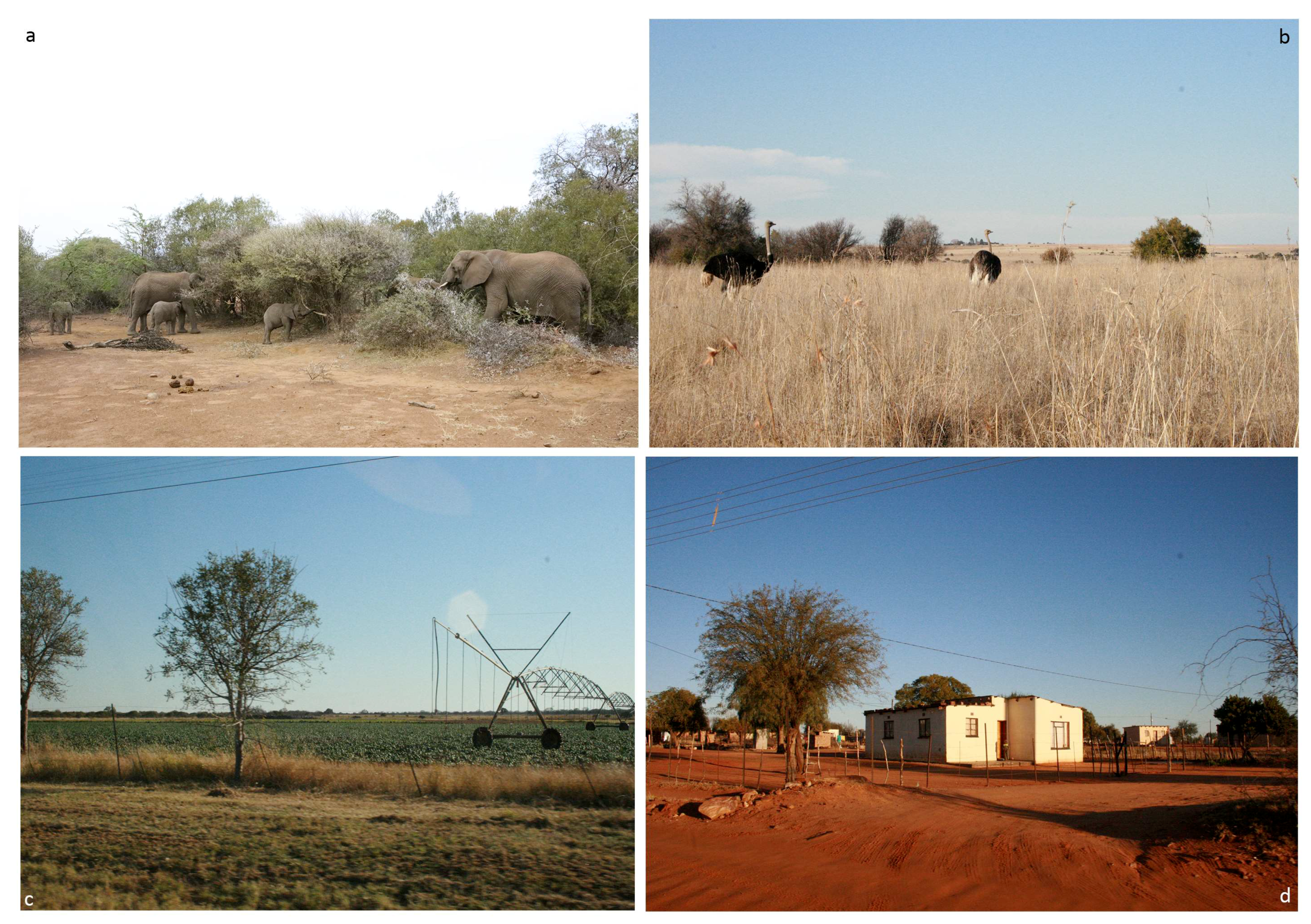
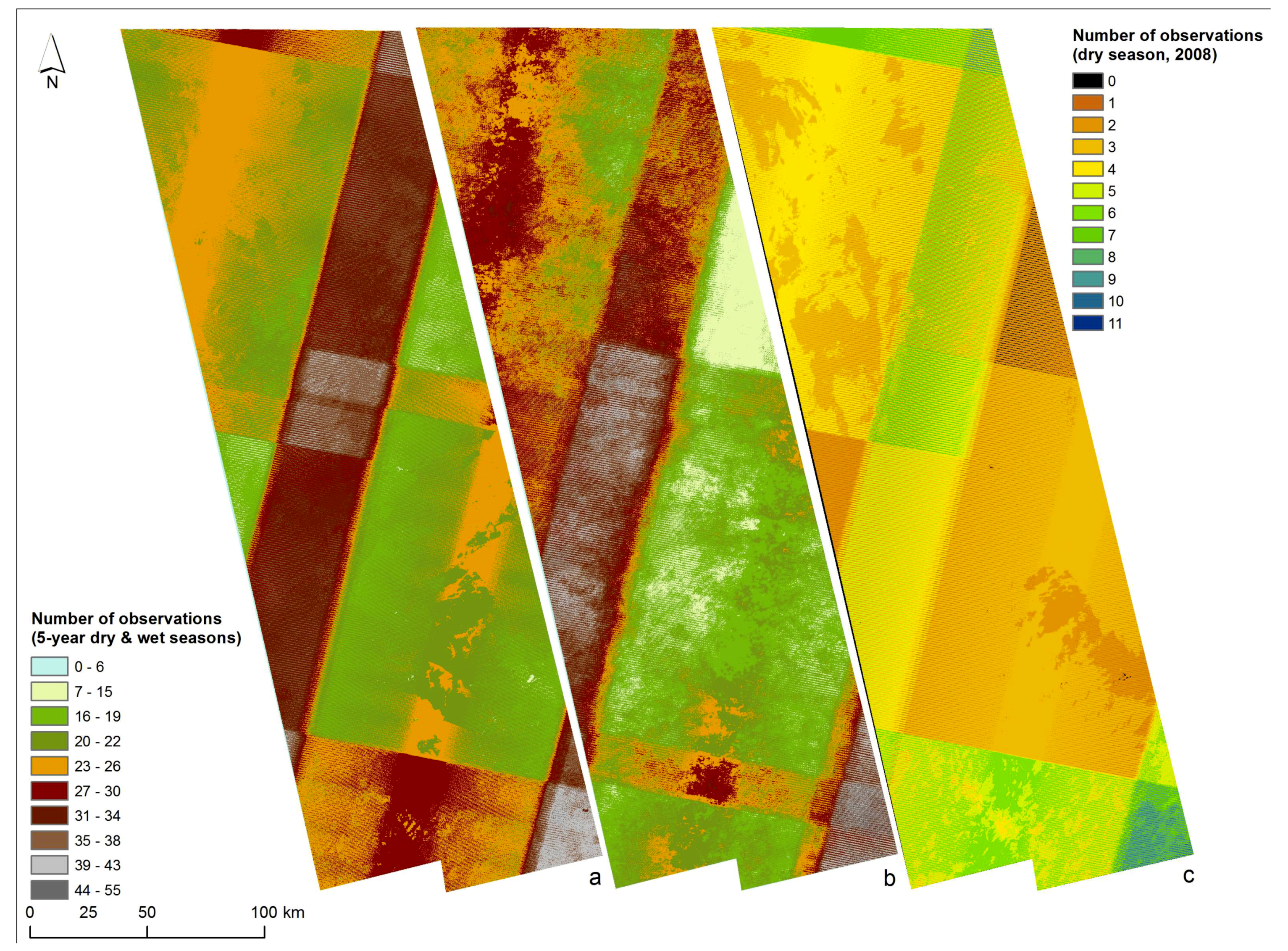

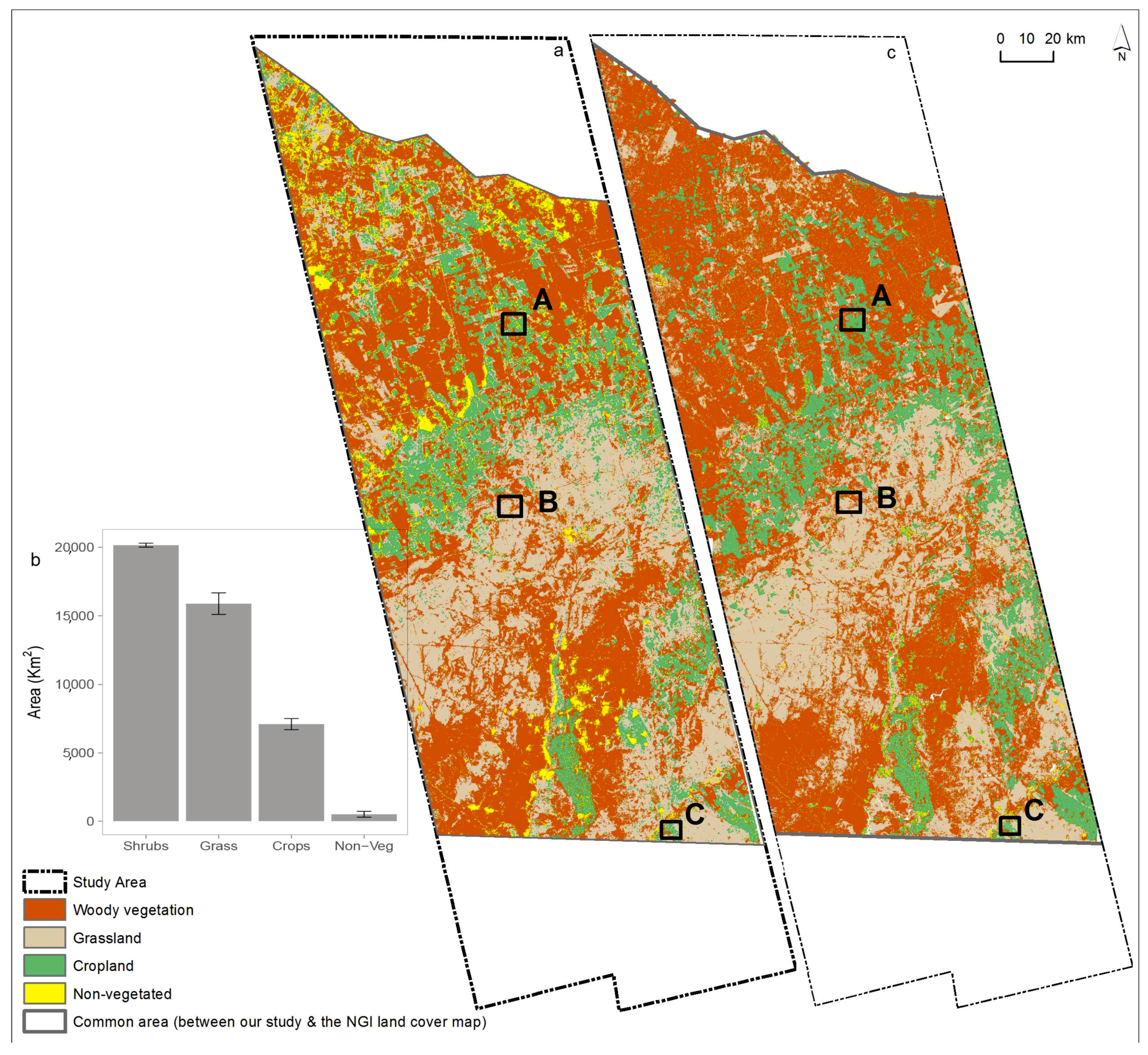

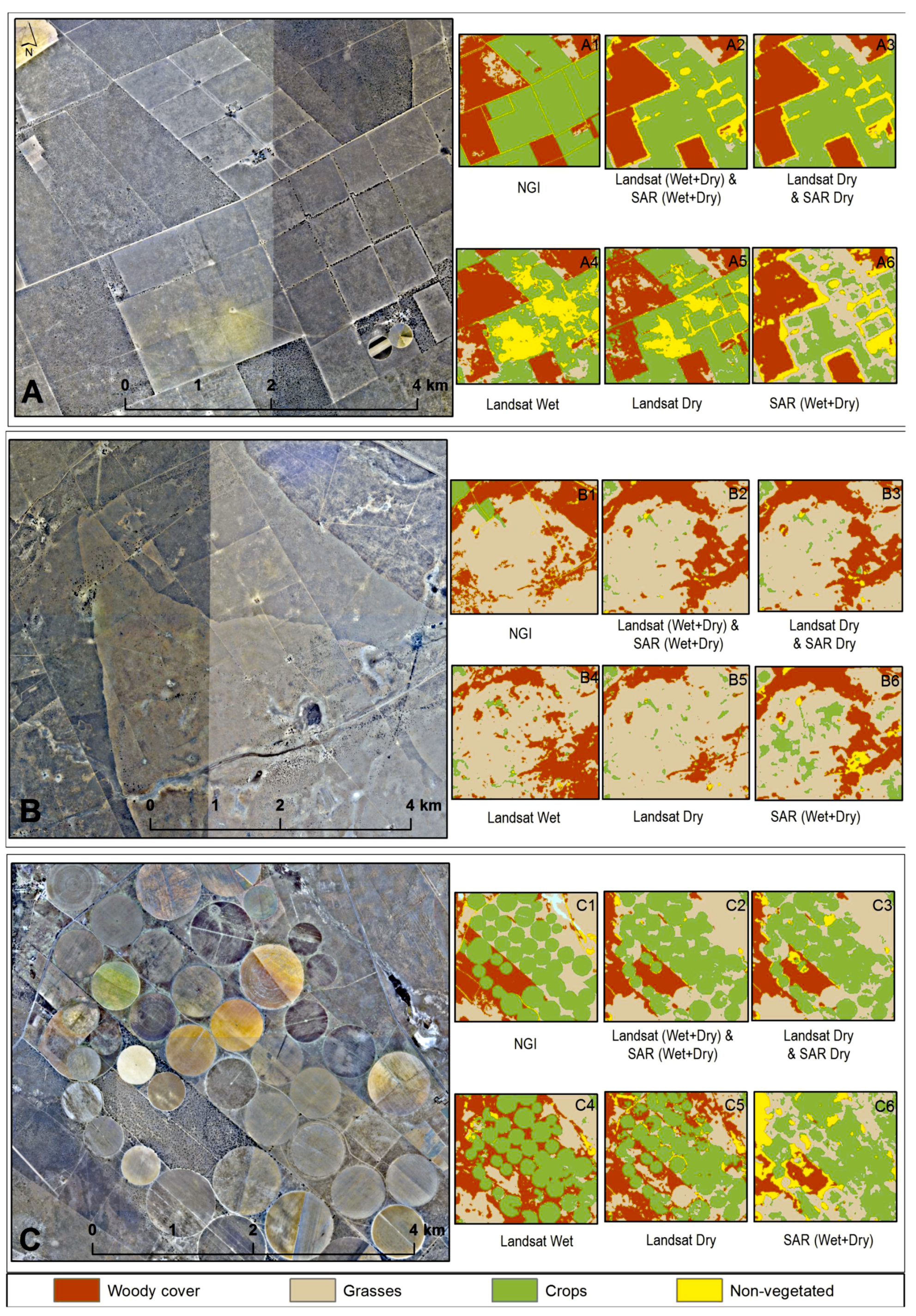
| Period | Start Date | End Date | Landsat 5 (TM) Scenes | Landsat 7 (ETM+) Scenes | L5 + L7 | Total # of Images Used |
|---|---|---|---|---|---|---|
| Dry | 02-6-2006 | 1-10-2006 | 35 | 29 | 64 | |
| 02-6-2007 | 1-10-2007 | 28 | 29 | 57 | ||
| 02-6-2008 | 1-10-2008 | 8 | 29 | 37 | ||
| 02-6-2009 | 1-10-2009 | 0 | 24 | 24 | ||
| 02-6-2010 | 1-10-2010 | 0 | 17 | 17 | Total Dry: 199 | |
| Wet | 01-1-2006 | 01-4-2006 | 5 | 19 | 24 | |
| 21-11-2006 | 31-3-2007 | 30 | 72 | 102 | ||
| 21-11-2007 | 31-3-2008 | 47 | 79 | 126 | ||
| 21-11-2008 | 31-3-2009 | 29 | 83 | 112 | ||
| 21-11-2009 | 31-3-2010 | 5 | 90 | 95 | ||
| 21-11-2010 | 31-12-2010 | 0 | 8 | 8 | Total Wet: 467 | |
| Total Dry + Wet: 666 | ||||||
| Polarization | Path | Frames | Date |
|---|---|---|---|
| FBS | 600 | 6610, 6620, 6630, 6640,6650, 6660 | 14-2-2008 |
| FBS | 600 | 6610, 6620, 6630, 6640,6650, 6660 | 2-3-2008 |
| FBD | 601 | 6610, 6620, 6630, 6640,6650, 6660 | 1-7-2008 |
| FBD | 601 | 6610, 6620, 6630, 6640,6650, 6660 | 18-7-2008 |
| Model # | Parameters Included | Number of Parameters |
|---|---|---|
| 1 | Dry Landsat All SAR | 95 |
| 2 | Dry Landsat Dry SAR | 80 |
| 3 | Dry Landsat Wet SAR | 50 |
| 4 | Dry Landsat | 35 |
| 5 | Wet Landsat All SAR | 95 |
| 6 | Wet Landsat Dry SAR | 80 |
| 7 | Wet Landsat Wet SAR | 50 |
| 8 | Wet Landsat | 35 |
| 9 | All Landsat All SAR | 130 |
| 10 | All Landsat Dry SAR | 115 |
| 11 | All Landsat Wet SAR | 85 |
| 12 | All Landsat | 70 |
| 13 | SAR All | 60 |
| 14 | SAR Dry | 45 |
| 15 | SAR Wet | 15 |
| Reference | User’s Accuracy | ||||||
|---|---|---|---|---|---|---|---|
| WV | G | C | NV | Total | |||
| Mapped | Woody vegetation (WV) | 475 | 3 | 1 | 5 | 484 | 0.98 |
| Grassland (G) | 9 | 295 | 15 | 4 | 323 | 0.91 | |
| Cropland (C) | 1 | 33 | 131 | 0 | 165 | 0.79 | |
| Non-vegetated (NV) | 32 | 4 | 0 | 74 | 110 | 0.67 | |
| Total | 517 | 335 | 147 | 83 | 1082 | ||
| Producer’s accuracy | 0.94 | 0.90 | 0.88 | 0.85 | |||
© 2018 by the authors. Licensee MDPI, Basel, Switzerland. This article is an open access article distributed under the terms and conditions of the Creative Commons Attribution (CC BY) license (http://creativecommons.org/licenses/by/4.0/).
Share and Cite
Symeonakis, E.; Higginbottom, T.P.; Petroulaki, K.; Rabe, A. Optimisation of Savannah Land Cover Characterisation with Optical and SAR Data. Remote Sens. 2018, 10, 499. https://doi.org/10.3390/rs10040499
Symeonakis E, Higginbottom TP, Petroulaki K, Rabe A. Optimisation of Savannah Land Cover Characterisation with Optical and SAR Data. Remote Sensing. 2018; 10(4):499. https://doi.org/10.3390/rs10040499
Chicago/Turabian StyleSymeonakis, Elias, Thomas P. Higginbottom, Kyriaki Petroulaki, and Andreas Rabe. 2018. "Optimisation of Savannah Land Cover Characterisation with Optical and SAR Data" Remote Sensing 10, no. 4: 499. https://doi.org/10.3390/rs10040499
APA StyleSymeonakis, E., Higginbottom, T. P., Petroulaki, K., & Rabe, A. (2018). Optimisation of Savannah Land Cover Characterisation with Optical and SAR Data. Remote Sensing, 10(4), 499. https://doi.org/10.3390/rs10040499





